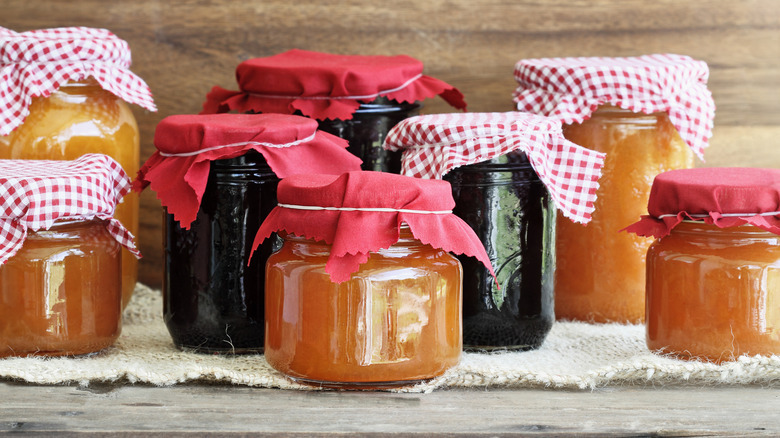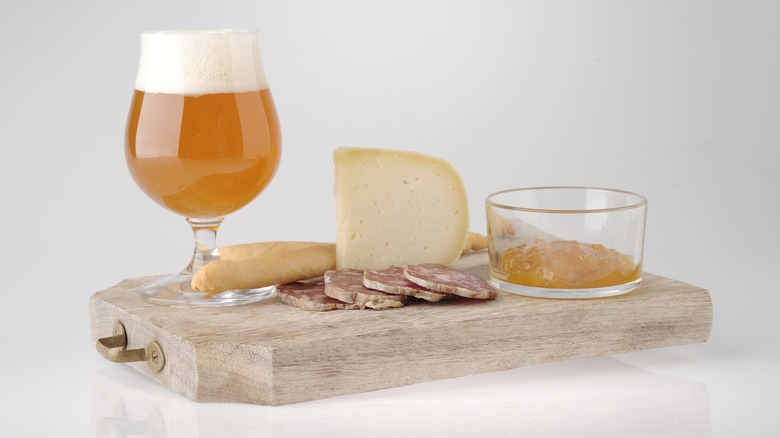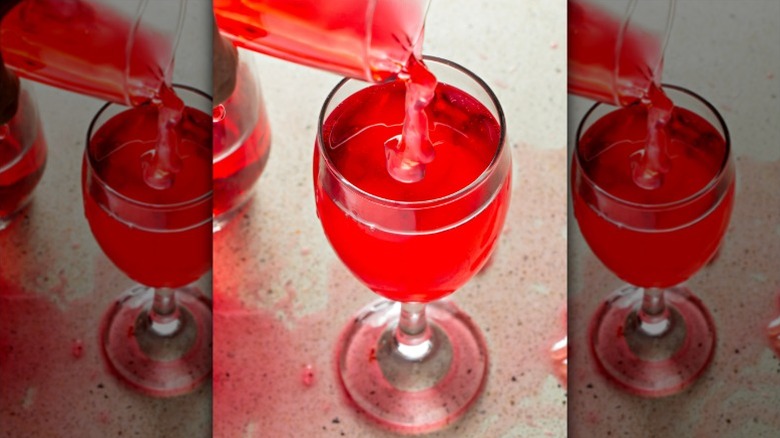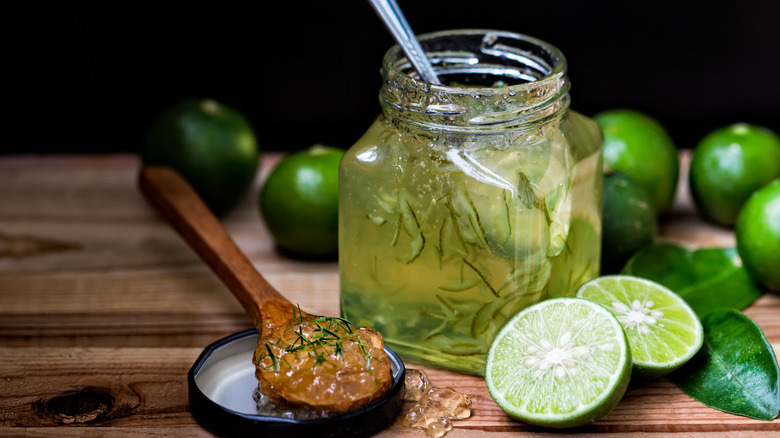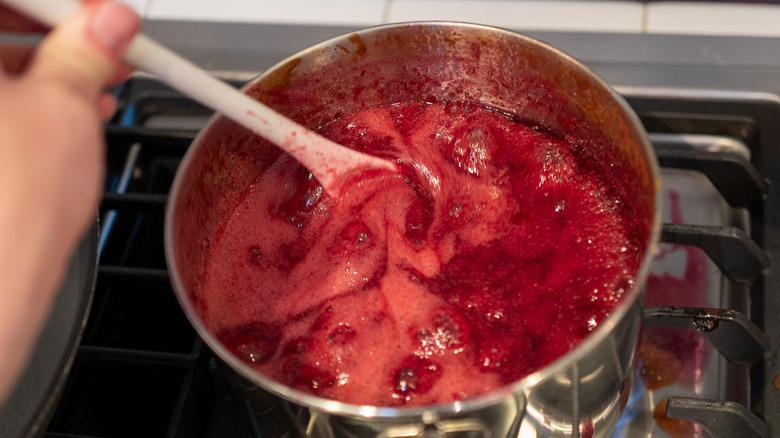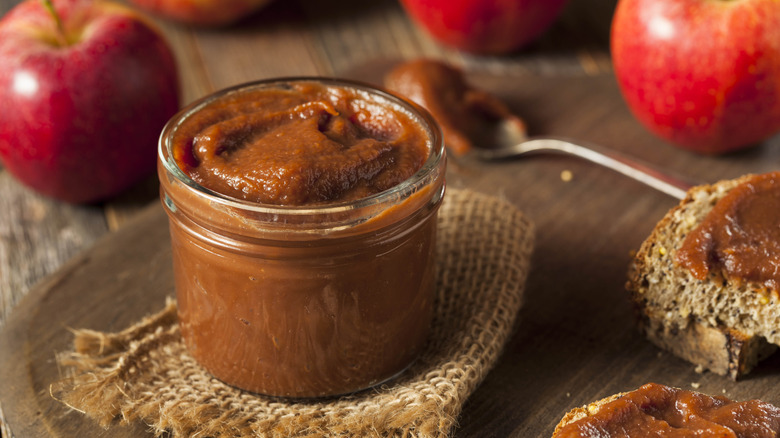5 Ways To Give Your Jams And Jellies A Boozy Edge
We may receive a commission on purchases made from links.
When we think of adding alcohol to breakfast, we generally focus on brunch drinks like vodka-spiked cold brew and bloody marys (or bloody Caesars, for Canadians and/or clam fans). Some cooks will also like to booze up their morning baking with a batch of breakfast stout muffins or something similar. On a much more subtle note, though, it's also worth introducing an alcoholic element to your daytime meal by way of spiked spreads.
Okay, so jams and jellies aren't just for spreading on toast at breakfast, they can also be used to fill thumbprint cookies or sandwich together a cake like Queen Consort Camilla's favorite Victoria sponge. Whatever your plans for the sweet condiments, there are a number of ways to create spirited flavor combinations. Some of these spreads involve fruit and booze, while others omit the produce and skip straight to the alcohol. Whichever kind you try, it's bound to make for some enjoyable brunchtime experimentation.
Beer jelly offers feisty fermented flavor
Beer jelly is a thing in Germany, but unfortunately, it doesn't seem to be one of that country's top exported items. This means that if you want to try it, your best bet may be a DIY approach. For every pint of beer, you'll want a pound of sugar, plus a packet of pectin. (Unlike jam made with fruit, the beer doesn't contain any natural pectin of its own.) You basically just boil the mixture for about four minutes, then pour a little onto a chilled plate to see if it gels, If it doesn't set up, you may need to add a pinch of citric acid. If it looks like jelly, though, it's ready to pour into a sterilized jar.
So what can you do with beer jelly, assuming your experiment works out? It would be great with pretzels, of course, since this snack is practically beer's BFF, although crackers and cheese would also work. A grilled cheese and beer jelly sandwich sounds pretty great too, especially if it's made with sharp cheddar and maybe a few slices of bacon or ham. Beer jelly would make a fantastic glaze for roast pork, as well. Yep, we've got a bit of a porcine cuisine theme going on here — must be the German influence.
If grape jam is your jam, try wine jelly
Wine jelly may not be something you'll see on a PB&J, but unlike beer jelly, you'll likely have an easier time sourcing it. Trappist Preserves' Burgundy Wine Jelly, for example, is made by Trappist monks at a Massachusetts monastery, but you needn't take a vow of silence to enjoy it nor to attempt making a similar treat yourself. As with homemade beer jelly, the main things you'll need are a wine of your choosing, sugar, and pectin, along with some lemon juice (a natural source of citric acid) to help it set up. For a slightly sweet jelly, aim for about 3 ½ cups of wine to 4 ½ cups of sugar, plus half a cup of lemon juice and a packet of pectin. (These typically weigh in around 1.75 ounces.) Importantly, after boiling the mixture for a minute, you'll have to remove any foamy stuff from the top of the jelly before pouring it into clean jars (or wine glasses for a really cute presentation). If you're thinking of storing the jars at room temperature, you'll also need to take the extra step of boiling them in water for five minutes.
As for what to do with your wine jelly, you could pour it over a block of cream cheese to make a simple, yet elegant dip for crackers. You could also spread some over a wheel of brie before baking or use spoonful ortwo as the glaze for roast beef.
Lime lovers will get a citrusy kick out of margarita jelly
And now we get to the hard stuff ... hard as in booze, that is, not the level of difficulty. Okay, sure, you could always make your own margarita jelly if you have a go-to marmalade recipe, but unlike Paddington Bear's favorite spread, we'd suggest swapping out the oranges for limes. You'll also be replacing some of the liquid in the recipe with tequila and orange liqueur — as a general suggestion, look to include one part of liqueur to two parts tequila and four parts of lime juice.
Of course, the easy way involves taking some storebought lime marmalade and simply stirring in a few tablespoons of the two liquors. You'll need to go easy, however, so as not to mess up the texture and wind up with margarita syrup. Not that this would be such a bad thing, since you could always pour it over sorbet or vanilla ice cream. If your margarita jelly stays gelled, though, it, too, would make a great cream cheese dip topper and could also be a glaze for chicken, fish, or shrimp.
Add a little nuttiness to red fruit jam with some amaretto
While you can find products like Dillman Farm Cherry Amaretto Preserves online, if you're looking for a homemade fruit jam recipe, we've got you covered. However, as it stands, it's booze-free. There's a simple fix for that, though: Macerate the fruit with the sugar and about ⅓ cup of liqueur ahead of time. Amaretto is an ideal choice because the almond flavor goes so well with the cherries that make up about half the jam, but Frangelico hazelnut liqueur or the Italian green walnut cordial known as nocino would also complement the strawberries and currants in the mix. After about 48 hours' soaking time, you can boil the fruit and sugar together with the reserved cherry pits. To compensate for the extra liquid, you may need to cook the jam a little longer before it gels, but it should get there in the end thanks to the miracle of evaporation.
Fruit jam with amaretto is as excellent on toast as it is delightful in baking. It's practically made for one of our favorite cakes, the classic chocolate-cherry Black Forest gateau, but honestly, we'd probably gobble up about half the jar straight from the spoon.
Whiskey is the way to upgrade apple condiments
Apples are incredibly versatile; the orchard all-stars can be turned into everything from homemade apple butter to jelly and jam. Making apple butter is exceedingly easy; all you need to do is slowly roast a bunch of apples with spices and some liquid to intensify their flavor, then blend. While our recipe calls for ginger ale, you could replace part of this with bourbon, blended whiskey, or even cinnamon-flavored whiskey. (All of these, needless to say, would also be excellent in a more standard apple jelly or jam recipe.)
For a rustic, savory alternative, try a jam made with apples, onions, booze, and bacon. You can infuse porky flavor right into the fruit by browning the apples in the fat left over from crisping up your bacon. Sweeten the mixture with brown sugar and maple syrup to taste, along with any additional seasonings you can think of, like garlic, pepper, or chile powder. For another apple component, a few tablespoons of cider vinegar will lend welcome fruity acidity, while a similar amount of the whiskey adds woody, caramel, and vanilla notes. After adding the bacon back to the pan, you can keep it chunky or let it cool slightly before adding it to a food processor for a smoother consistency. Eat it as-is with crackers or a big hunk of bread; sliced tart apples and sharp cheese would also make for perfect accompaniments.
Clearly, jams and jellies offer the perfect canvas for the bold flavors of your favorite alcohols. Once you've got a few jam sessions under your belt, it should be easy for you to mix and match flavors to your heart's content.
